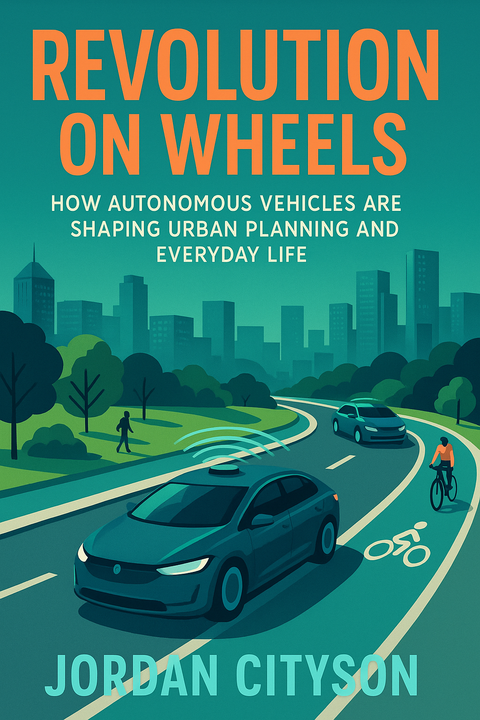
Revolution on Wheels
How Autonomous Vehicles Are Shaping Urban Planning and Everyday Life
Included:
✓ 200+ Page AI-Generated Book
✓ ePub eBook File — read on Kindle & Apple Books
✓ PDF Print File (Easy Printing)
✓ Word DOCX File (Easy Editing)
✓ Hi-Res Print-Ready Book Cover (No Logo Watermark)
✓ Full Commercial Use Rights — keep 100% of royalties
✓ Publish under your own Author Name
✓ Sell on Amazon KDP, IngramSpark, Lulu, Blurb & Gumroad to millions of readers worldwide
Explore the Future of Urban Mobility
In "Revolution on Wheels," we dive into the transformative impact of autonomous vehicles (AVs) on urban planning and daily life. As technology advances, these vehicles are set to redefine our cities, offering innovative solutions to longstanding urban challenges.
The Paradigm Shift in City Design
This book paints a vivid picture of how AVs are expected to reshape the physical landscape of urban areas. With more efficient land use, we envision wider sidewalks, dedicated bike lanes, and green parks replacing expansive parking lots. By reducing the need for private car ownership, AVs create opportunities for a human-centered approach to urban design, where people come first.
Enhancing Mobility and Accessibility
Imagine a city where shared mobility services, like robo-taxis and on-demand shuttles, enhance accessibility and affordability for all demographics. This book delves deep into the potential of AVs to improve public transit systems, ensuring that services reach those who need them most. Enhanced connectivity fosters a vibrant community life and offers new possibilities for social interactions.
Economic and Environmental Impacts
The shift to autonomous technologies also has profound economic implications. With a decrease in the demand for gas stations and parking spaces, cities can redirect resources toward better public services and infrastructure. Furthermore, AVs promise to reduce traffic congestion, lower emissions, and create cleaner, greener cities, ultimately contributing to sustainability efforts.
Challenges and Considerations
While the benefits of AVs are promising, effective regulations and equitable access are crucial to overcoming technological hurdles. This book emphasizes the importance of a fair transition, ensuring that advancements in mobility systems work for everyone, not just a select few.
Conclusion
"Revolution on Wheels" is not just about technology; it's about envisioning livable cities where residents can thrive amidst innovative transport solutions. Packed with research, expert insights, and visionary ideas, this book invites urban planners, policymakers, and everyday readers to engage with the future of urban living.
Table of Contents
1. The Rise of Autonomous Vehicles- What Are Autonomous Vehicles?
- The Technology Behind AVs
- Global Trends in AV Adoption
2. Redefining Urban Spaces
- Impact on City Design
- Reducing Parking Needs
- Creating Green Spaces
3. Mobility and Accessibility
- Enhanced Public Transit Solutions
- Robo-Taxis and Shared Mobility
- Inclusion and Accessibility for All
4. Economic Shifts
- Changes in Transportation Economics
- Effects on Employment and Jobs
- Redirecting Urban Investments
5. Environmental Benefits
- Lowering Carbon Emissions
- Promoting Sustainable Practices
- Urban Heat Island Reduction
6. Traffic Safety Revolutionized
- Reducing Accidents and Injuries
- Improving Traffic Flow
- Regulating AVs for Safety
7. Challenges of Integration
- Technological Barriers
- Regulatory Frameworks Needed
- Public Acceptance and Trust
8. Case Studies: Cities Leading the Charge
- Examining Pioneering Cities
- Lessons Learned from Early Implementations
- Future Plans and Milestones
9. Social Implications of AVs
- Impact on Daily Commuting
- Changing Social Interactions
- New Opportunities for Urban Living
10. The Role of Data and Privacy
- Data Collection in Autonomous Systems
- Privacy Concerns and Solutions
- Ethics of AV Data Usage
11. The Future of Urban Planning
- Visioning Smart Cities
- Integrating VR and AV Technology
- Long-term Sustainability Goals
12. Preparing for Tomorrow
- Keeping Up with Rapid Changes
- Engaging Stakeholders and Communities
- Creating a Roadmap for Success
Target Audience
This book is for urban planners, policymakers, researchers, students, and anyone interested in the intersection of technology, transportation, and urban living.
Key Takeaways
- Understanding the transformative role of autonomous vehicles in urban planning.
- Insights into how AVs are reshaping mobility and accessibility for diverse populations.
- Exploring economic, social, and environmental implications of AV integration.
- Strategies for overcoming challenges in implementing autonomous technologies responsibly.
- Research-backed predictions for the future of cities in a world dominated by AV technology.
